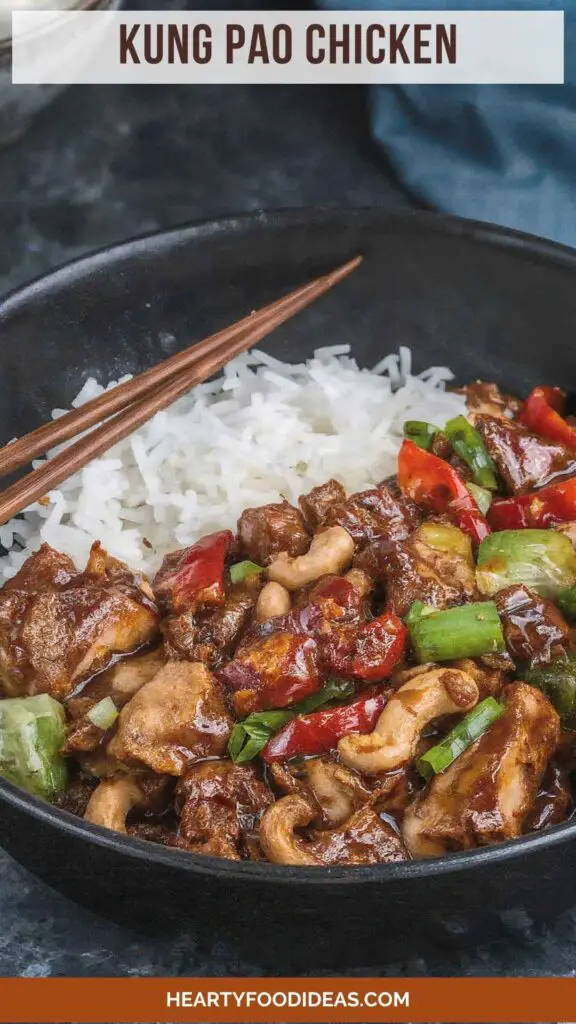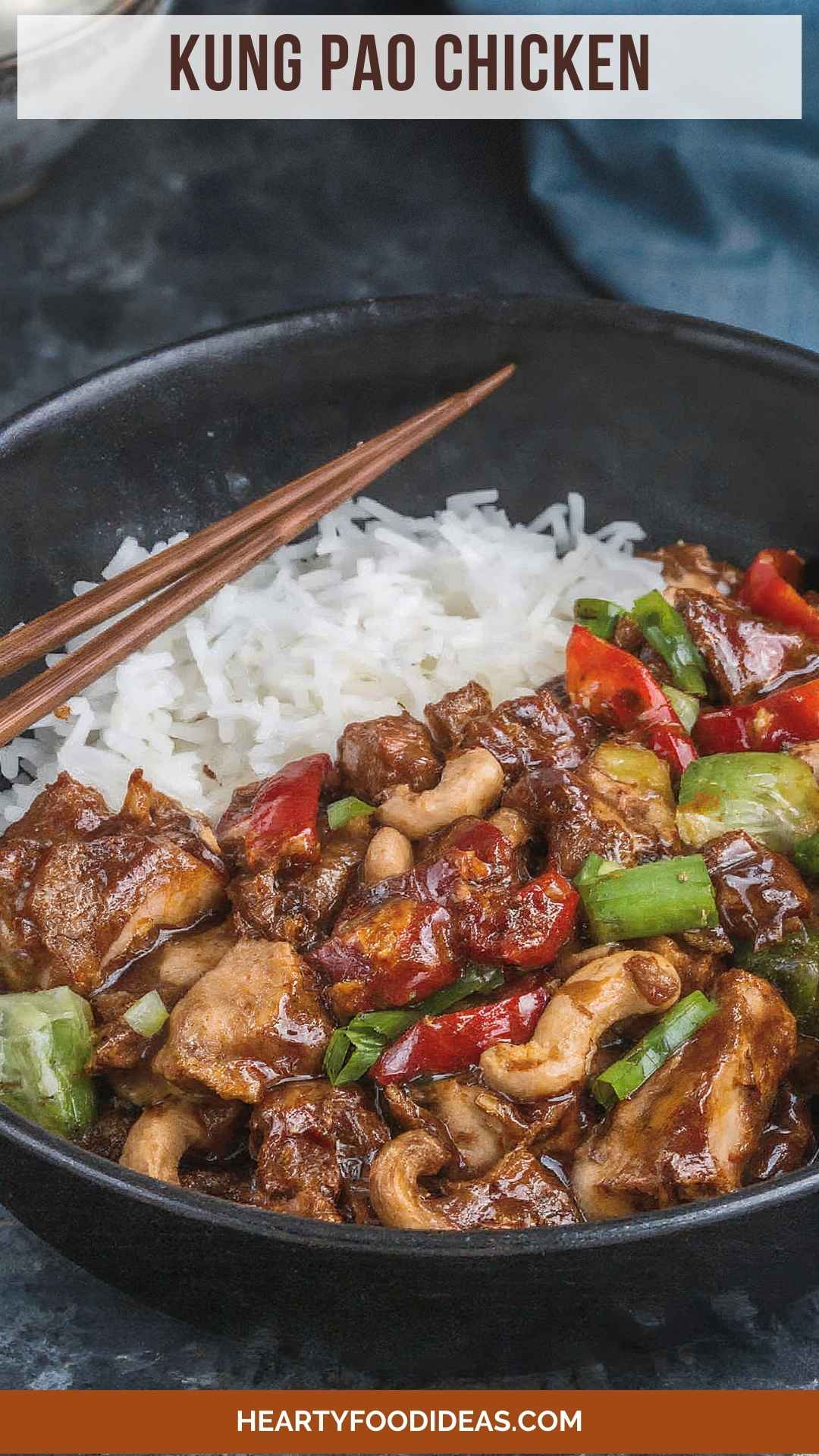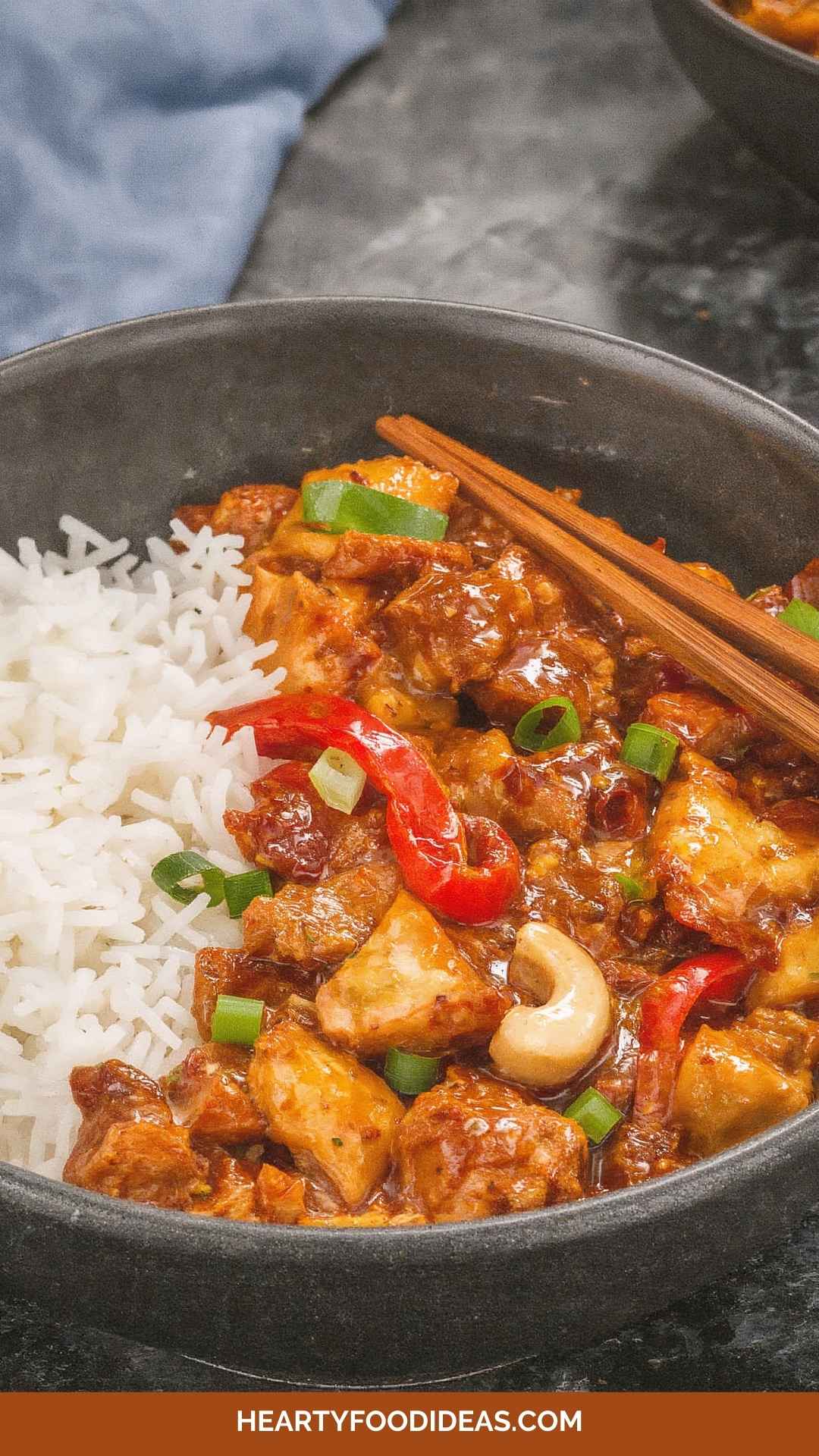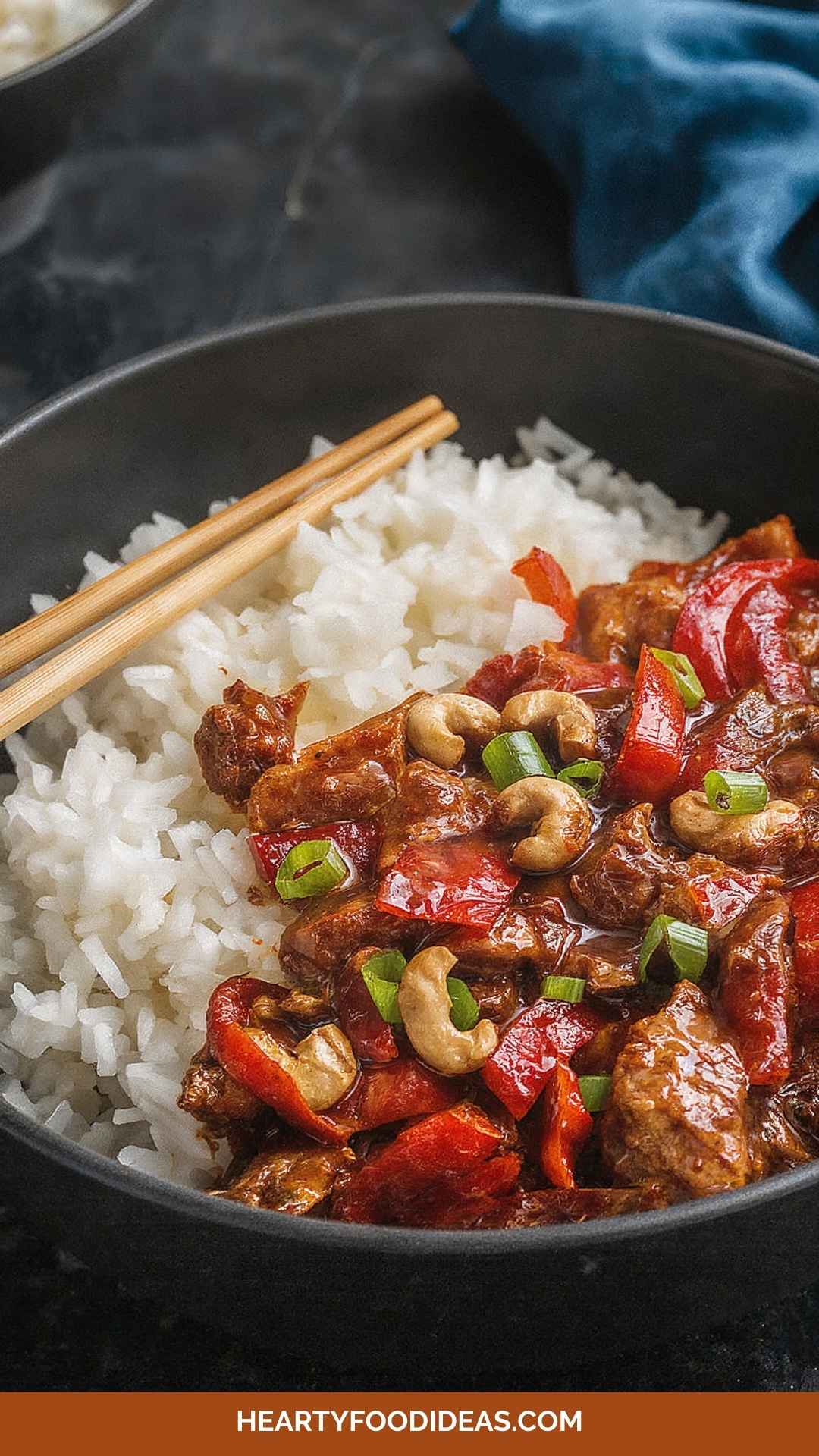Before diving into the culinary adventure of making a 25-minute Kung Pao chicken, let’s chat about the delightful components that can elevate this dish even more. Picture pairing your spicy, flavorful chicken with fluffy jasmine rice. The rice soaks up that savory sauce while balancing out the heat.
Perhaps you want to throw in some steamed broccoli or snap peas for crunch and color. Or how about a light cucumber salad? The cool, refreshing taste of cucumbers complements the spices beautifully. Trust me, these pairing options will take your meal from good to unforgettable!
Why This Recipe Works?
Let’s talk a bit about what makes this Kung Pao chicken recipe truly shine.
1. Speedy Preparation
This dish takes merely 25 minutes from prep to table. It’s perfect for busy weeknights or last-minute gatherings.
2. Fresh and Flavorful Ingredients
By using fresh chicken, ginger, and vibrant veggies, this recipe delivers on taste. Fresh ingredients elevate the traditional flavors and create that satisfying crunch.
3. Perfect Balance of Flavors
The sauce recipe strikes a fine balance between sweet, salty, and spicy. Quality ingredients like aged balsamic vinegar and toasted sesame oil enhance those flavors.
4. Customizable
You can easily adjust the heat level by altering the amount of chili flakes. Want it spicy? Go for it. Like it milder? Just cut back on the spice.
How Does It Taste Like?
Imagine biting into tender chunks of chicken drenched in a perfect blend of savory sauces. You’ll get a burst of heat from the chilies, combined with a slightly sweet undertone from the brown sugar. There’s a nuttiness from the toasted sesame oil and the roasted peanuts add that much-needed crunch. The fresh ingredients finish things off. Each bite is an explosion of flavor that keeps you coming back for more.
What Sets This Recipe Apart from Other 25-Minute Kung Pao Chicken Variations?
You might wonder how this recipe stands out amid a sea of similar dishes. First off, my twist includes two unexpected ingredients: fresh lime juice and rice vinegar. These add brightness and balance to the overall flavor. Additionally, sticking to low-sodium soy sauce keeps it heart-healthy without sacrificing taste.
I also use cornstarch in the recipe thoughtfully, ensuring the chicken stays moist and tender, while also maintaining the right thickness in the sauce.
The Ingredients
Let’s gather what we need—a solid foundation is the key to any great dish!
For the Marinade:
- 1½ lbs chicken tenderloins (or boneless, skinless chicken breast), cut into 1-inch cubes
- 1½ tablespoons low-sodium soy sauce
- 1 tablespoon dry cooking sherry (or Shaoxing wine)
- 2 teaspoons cornstarch
- 1 teaspoon fresh lime juice (this new addition adds brightness)
For the Sauce:
- 2 tablespoons light soy sauce
- 1 tablespoon hoisin sauce (choose a quality brand like Lee Kum Kee or Kikkoman)
- 1½ tablespoons light brown sugar
- 1 tablespoon aged balsamic vinegar
- 1 tablespoon toasted sesame oil
- 1 tablespoon cornstarch
- ⅓ cup water
- 1 teaspoon rice vinegar (this balances out the sweetness nicely)
- ½ teaspoon crushed red chili flakes (reduce for less heat)
- ¼ teaspoon ground ginger
For the Stir-fry:
- 2½ tablespoons neutral vegetable oil
- 3 garlic cloves, finely chopped
- 1 large red bell pepper, diced into bite-size pieces
- 2 celery stalks, halved lengthwise and sliced thin
- 5 scallions, white and green parts thinly sliced
- ⅓ cup roasted, unsalted peanuts or cashews
- ¼ teaspoon sea salt
- ½ teaspoon sesame seeds (a new addition for a nutty garnish)
Instructions
This is where the magic happens! Follow these steps and get ready for some delicious Kung Pao chicken.
Step 1: Marinate the Chicken
Start by placing your chicken in a bowl. Add 1½ tablespoons of low-sodium soy sauce, 1 tablespoon of dry sherry, 2 teaspoons of cornstarch, and 1 teaspoon of fresh lime juice. Stir well to coat all pieces. Allow the chicken to marinate for at least 10 minutes—this helps infuse flavor and tenderizes the meat.
Step 2: Prepare the Sauce
In a separate bowl, combine 2 tablespoons of light soy sauce, 1 tablespoon of hoisin sauce, 1½ tablespoons of brown sugar, 1 tablespoon of balsamic vinegar, 1 tablespoon of sesame oil, 1 tablespoon of cornstarch, and ⅓ cup of water. Whisk until the ingredients are well blended and the cornstarch is dissolved. You should have a smooth mixture.
Step 3: Heat the Oil
In a large skillet or wok, heat 2½ tablespoons of vegetable oil over medium-high heat. You want it hot but not smoking. If it starts smoking, turn the heat down a bit.
Step 4: Stir-fry the Chicken
Once the oil is hot, add the marinated chicken into the skillet. Spread it out so it cooks evenly. Stir-fry for about 4-5 minutes, or until the chicken is golden brown and cooked through. Remove the chicken from the skillet and set it aside.
Step 5: Cook the Veggies
In the same skillet, add 3 finely chopped garlic cloves, 1 diced red bell pepper, and 2 sliced celery stalks. Stir-fry for about 3 minutes or until the vegetables are just tender but still crisp.
Step 6: Combine and Sauce it Up
Return the chicken back into the skillet. Add the prepared sauce along with 1 teaspoon of rice vinegar, ½ teaspoon crushed red chili flakes, and ¼ teaspoon ground ginger. Stir everything together, ensuring the chicken and vegetables are well coated. Cook for another 2-3 minutes or until the sauce is thickened.
Step 7: Garnish and Serve
Finally, toss in ⅓ cup of roasted peanuts or cashews, adding a bit of crunch. Season with salt to taste. If desired, sprinkle on some sesame seeds for that finishing touch. Serve immediately over rice or alongside your chosen sides.
Notes
To make this recipe even better, keep the following tips in mind:
Quality Matters: Invest in good soy sauce and sesame oil. The flavors will shine through.
Avoid Overcooking: Take care not to overcook the chicken. It should be tender and juicy.
Prep Ahead: You can marinate the chicken ahead of time. Just toss it in the fridge until you’re ready to cook.
Adjust for Heat: Feel free to adjust the chili flakes for your preferred spice level.
Vegetable Variations: Add or substitute vegetables like zucchini, broccoli, or snap peas based on what you have on hand.
Nutrition Information
This 25-minute Kung Pao chicken yields approximately four servings. Each serving contains around:
- Calories: 400
- Protein: 30g
- Carbohydrates: 20g
- Fat: 23g
- Fiber: 3g
- Sugars: 5g
These figures are an estimate and may vary based on ingredient brands and specific measurements.
How Do You Store This 25-Minute Kung Pao Chicken?
Once your Kung Pao chicken is cooked, if you happen to have leftovers (which is rare, but it happens!), allow it to cool to room temperature. Transfer it to an airtight container and store it in the refrigerator for up to 3 days. To reheat, simply microwave it or warm it in a skillet over low heat, adding a splash of water to loosen the sauce.
Sides For 25-Minute Kung Pao Chicken
Here are a few side dish ideas that perfectly complement your Kung Pao chicken:
1. Fluffy Jasmine Rice
Its delicate flavor absorbs the sauce beautifully. Cook it up in about 18 minutes, and it’s a simple foundation for your main dish.
2. Steamed Broccoli
Lightly steamed broccoli pairs wonderfully. The crisp texture contrasts with the soft chicken and adds a vibrant green to your plate. Just steam until bright green and tender.
3. Cucumber Salad
Slice up some cucumbers, toss them with rice vinegar, sesame oil, and a pinch of salt. This cool, refreshing salad offers a nice balance to the spicy chicken.
What Alternatives Can You Use for the Ingredients If They Are Not Present in Your Kitchen?
We all have those days when certain ingredients are mysteriously missing. No need to panic! Here are some alternatives to consider:
1. Chicken Substitutes
If you don’t have chicken tenderloins, feel free to use shrimp or tofu. Both options are delicious!
2. Soy Sauce Replacement
For a gluten-free alternative, tamari works well. If you’re avoiding soy altogether, coconut aminos can be a great substitute.
3. Hoisin Sauce Alternate
If hoisin sauce isn’t on hand, try using a mix of soy sauce and some honey or maple syrup for sweetness.
4. Vegetable Oil Options
Canola or sunflower oil can work in place of vegetable oil. They’ll give you that same neutrality in flavor.
Conclusion
Now that you have all the insider information, I hope you’re excited to whip up this 25-minute Kung Pao chicken. The joy of cooking is not just in the result but in the process. Gather your ingredients, follow the steps, and let the wonderful aromas fill your kitchen. Whether it's for a quick dinner after a long day or a fun gathering with friends, this recipe is a sure win. Encourage experimentation; the best part of cooking is making it your own. Enjoy every bite!
You’ll also like the following recipes!





